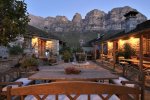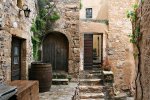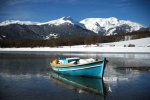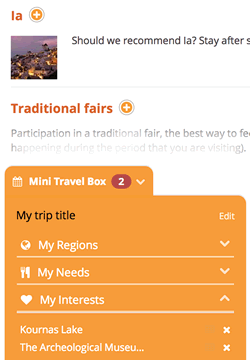A touch of white on the deep blue Cycladic background is the main sign of a long lasting civilization that has influenced the island’s culture. It is not only distinguished because of its history, but also because of the fact that it attracts visitors of the Cyclades like a magnet and introduces them to a climate of vivacity, freshness, and serenity.
Paros charms you from the moment the ship approaches the port of Parikia and passes through “Portes” (Doors), the reef that welcomes you. Casting a glance at its port, crowded during summer months, one can see many tourists hastily looking for familiar faces or for the boarding point for buses that provide itineraries towards the various parts of the island. However, putting aside the touristic mantle, the capital lies like a white veil all along the western part of the island. A short walk in the all-white alleys of Parikia includes the old market, the famous Panagia Ekatontapiliani (Our Lady of the Hundred Gates), as well as the Venetian castle, which, for many people, is the “ace card” of our region, since the sunset from there is breathtaking.
The sea surrounding the island, which is sometimes troubled from the north winds and sometimes calm, embraces the varied coastline, where rocky and steep coasts alternate with natural small ports and peaceful beaches, mainly to the east. The soil of the island, which is rocky and rich in limestone, has been a source of raw material since antiquity, providing the famous all-white marble of Paros. The island has a temperate, Mediterranean climate, with mild winters and warm summers cooled by the well-known north winds of August, the etesian winds. Paros presents rich flora, and hosts several migratory birds in its habitats, including several endangered species like the Mediterranean Shag, the Long-legged Buzzard, the Glossy Ibis, the Purple Heron and others.
Paros, being part of the Cycladic civilization, seems to have been inhabited since the 4th millennium B.C. The coastal, unfortified settlements of that era indicate a peaceful civilization with trade as its main occupation. During the governance of the Minoan civilization in the Aegean Sea, the island, with its advantageous position, favored transportation and transfers, so the Cretans colonized the island by building a city which they named Minoa. The collapse of the Minoan civilization coincides with the emergence of the Mycenaean civilization, samples of which have been found in the area of Koukounaries. At the beginning of the new millennium and of the Geometric period, however, the island was occupied by the Arcadians and was named “Paros”, after their leader.
During the Archaic period (700-480 B.C.) a new and active tribe was essentially created, which colonized Thasos in 706 B.C. and continued to spread. Then, the arts, like pottery, sculpture, and poetry, with Archilochus as its representative, found fertile ground to grow, while important projects were created with the use of the marble of Paros. Furthermore, Paros had a significant naval force and stood by the Persians against the Athenian domination during the Persian Wars. During its history, throughout the centuries, it had known many occupiers, invaders, alliances, before coming to the Romans with the death of Alexander the Great. During the 1st century A.D., like other islands of the Cyclades, Paros was used as a place for the exile of the unwanted, eminent Romans. After the issue of the Edict of Milan on religious freedom (313 A.D.), the first Christian temple was built in Paros, the temple of Agios Nicolaos (Saint Nicholas), which is, until today, part of the ecclesiastical complex of Panagia Ekatontapiliani (Our Lady of the Hundred Gates). At the end of the byzantine era, and in particular, during the Venetian domination, the island suffered from pirates, as is evidenced from the three castles of the era: the one in Parikia, Ag. Antonios Kefalos, and Naoussa. Then, following a parallel history with the rest of Greece, Paros was conquered by the Turks in 1537. For the next two centuries, the safe caves of the island became pirate operation bases, resulting in many catastrophes on the island, like the one of 1666 where the monastery of Panagia Ekatontapiliani was destroyed. The island participated actively both in the Russian-Turkish wars 1770-1777, since the Russians found refuge in the port of Naoussa as an operation base, and in the Revolution of 1821, during which it received many refugees from the surrounding areas. Finally, Paros was incorporated into the new Greek state and at the end of the 18th century succeeded in attracting tourism, following an upward course.
Despite the rapid tourism boom it has known during its modern history, the rich folklore of the island managed to be saved through cultural activities like musical, theatrical, and dance performances, and representations of events which mainly take place during the summer months.
Of course these are only a few details about a place which may initially seem to be noisy, but which has much hidden beauty to explore.
Use the map or the alphabet below to find your favorite destination!
Achaea Prefecture
Aegina
Aetoloakarnania Prefecture
Agathonisi
Agistri
Alonissos
Amorgos
Anafi
Andros
Antiparos
Arcadia Prefecture
Argolida Prefecture
Arta Prefecture
Astypalea
Attiki Prefecture
Kalymnos
Karditsa Prefecture
Karpathos
Kasos
Kastelorizo
Kastoria Prefecture
Kavala Prefecture
Kea (Tzia)
Kefalonia
Kerkyra (Corfu)
Kilkis Prefecture
Kimolos
Korinthia Prefecture
Kos
Koufonisi (Ano & Kato)
Kozani Prefecture
Kythira - Antikythira
Kythnos
Samos
Samothrace
Santorini
Schinoussa
Serifos
Serres Prefecture
Sifnos
Sikinos
Skiathos
Skopelos
Skyros
Spetses
Symi
Syros
Would you like to combine skiing in the morning and then go swimming in the afternoon, all in one region? Click to choose your interests and see in which part of Greece you enjoy them. Combinations are endless!










